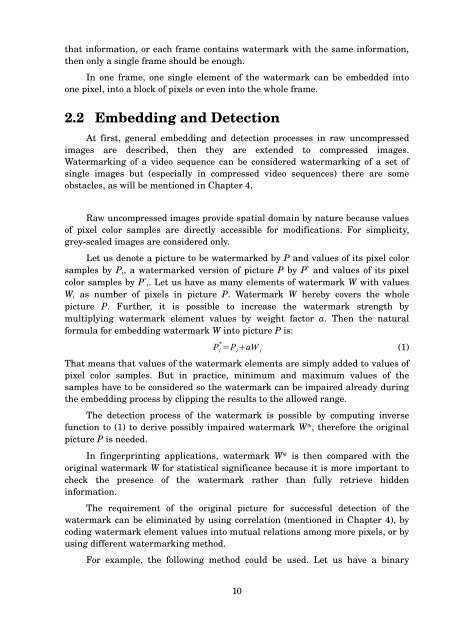MASTER THESIS Video Watermarking - Computer Graphics Group ...
MASTER THESIS Video Watermarking - Computer Graphics Group ...
MASTER THESIS Video Watermarking - Computer Graphics Group ...
Create successful ePaper yourself
Turn your PDF publications into a flip-book with our unique Google optimized e-Paper software.
that information, or each frame contains watermark with the same information,<br />
then only a single frame should be enough.<br />
In one frame, one single element of the watermark can be embedded into<br />
one pixel, into a block of pixels or even into the whole frame.<br />
2.2 Embedding and Detection<br />
At first, general embedding and detection processes in raw uncompressed<br />
images are described, then they are extended to compressed images.<br />
<strong>Watermarking</strong> of a video sequence can be considered watermarking of a set of<br />
single images but (especially in compressed video sequences) there are some<br />
obstacles, as will be mentioned in Chapter 4.<br />
Raw uncompressed images provide spatial domain by nature because values<br />
of pixel color samples are directly accessible for modifications. For simplicity,<br />
grey-scaled images are considered only.<br />
Let us denote a picture to be watermarked by P and values of its pixel color<br />
samples by Pi, a watermarked version of picture P by P * and values of its pixel<br />
color samples by P * i. Let us have as many elements of watermark W with values<br />
Wi as number of pixels in picture P. Watermark W hereby covers the whole<br />
picture P. Further, it is possible to increase the watermark strength by<br />
multiplying watermark element values by weight factor a. Then the natural<br />
formula for embedding watermark W into picture P is:<br />
<br />
<br />
That means that values of the watermark elements are simply added to values of<br />
pixel color samples. But in practice, minimum and maximum values of the<br />
samples have to be considered so the watermark can be impaired already during<br />
the embedding process by clipping the results to the allowed range.<br />
The detection process of the watermark is possible by computing inverse<br />
function to (1) to derive possibly impaired watermark W*, therefore the original<br />
picture P is needed.<br />
In fingerprinting applications, watermark W* is then compared with the<br />
original watermark W for statistical significance because it is more important to<br />
check the presence of the watermark rather than fully retrieve hidden<br />
information.<br />
The requirement of the original picture for successful detection of the<br />
watermark can be eliminated by using correlation (mentioned in Chapter 4), by<br />
coding watermark element values into mutual relations among more pixels, or by<br />
using different watermarking method.<br />
For example, the following method could be used. Let us have a binary<br />
10<br />
(1)
















